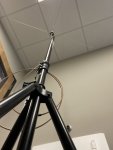Lots of good suggestions here. I'm going to drill a bit deeper. It depends on what you define as "Northern California" and/or your area of interest. For me, a BCT-15X analog scanner is the gold standard for analog rural NorCal reception. Cheap in price, and ears that can hear a whisper a hundred miles away (with an antenna of course). Easy to manually program/edit in the field, you can use FreeScan and ProScan for computer programming.
Your area of interest is what determines if you get the $175 analog BCT-15X or the $400-500 digital BCD0996/536 radios, or the new $600-700 SDS-100 or SDS-200. Placer County Sheriff and the I80 corridor is P25 VHF trunked. Also some National Parks are 50/50 P25, and some smaller national lands might be full P25. Forest Service is all analog here, with law enforcement dabbling in but not fully digital yet. Fish and Game, BLM, NDF, ODF, etc are all analog. State Parks up here is analog VHF/800, but there is a slow push for P25 700Mhz in some places. Basically the bulk of where you RV will likely be analog, but there will be bits of P25 invading the sanctity of our analog ruralness, and tiny increments over the next 5 years. Check The Database and see what there is around your favorite hangouts.
Now handheld or mobile/base? Do you want this while driving around up front, or while the awning is out, leg rest up, and ice chest open? A handheld covers both, but you'll have to unplug it from the front wiring (power and antenna) and move it to the lawn chair and potentially different power source and/or antenna. So think of those logistics.
Antennas - once rural, and especially in the forest, you won't hear much of anything with a rubber duck or small telescopic antenna. Vehicle mounted is best, but RV's tend to both be fiberglass, negating mag mounts, and tall, which means trees will likely eat anything sticking up more than 6" above deck. So you'll need to think of a mounting solution that can either be moved and protected from trees, and/or something that provides a ground plane. 1/4 wave antennas work best in more open land (valley's, plains etc) while 5/8 wave antennas have a steeper pattern to them that work great in canyons and mountains, but they are taller. If the bulk of your scanning is done under the awning or in the lounge chair, can I suggest a portable tripod and 1/4 wave antenna kit? I like to use speaker stands for tripods. Google TS88GB for a stand that goes up 9'. FullCompass is the primary vendor for
that, around $65. Or you can get down into the $40-50 range for a pair of
shorter 6' stands. (use the other one for a light, or a ham antenna.) Clamp on a PVC extension and even better. Then grab a mobile-to-base antenna mount,
any of these, as well as an NMO wideband antenna that covers your favored band (VHF-Hi?) like the
Laird B132S which you can even use and take off of the truck if a 5th wheel...or even an
NMO tri-band scanner antenna. Now you have a field antenna setup for about $100-120, that can be moved and adjusted easily, withstands regular winds (heavy winds with a sandbag) and weather-proof so can be left outside overnight. Find a basic length of RG-58 coax to get from antenna to your radio, whether to the lawn chair or find a way to sneak it inside for listening indoors.

Power - batteries in a handheld, or extend some 12VDC from the RV somewhere to your lawn chair...
And as far as zipcode or GPS scanning that others are mentioning. Those are great tools for travelling into unknown areas, but I'm not sure they'll accurately turn on your USFS, state/natl parks. Can others with experience here chime in? I'm curious myself.


